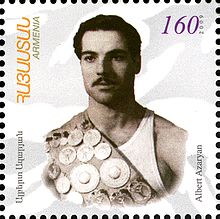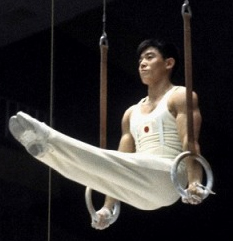
The men's rings was a gymnastics event contested as part of the Gymnastics at the 1964 Summer Olympics programme at the Tokyo Metropolitan Gymnasium. The event was held on 18, 20, and 22 October. There were 128 competitors from 29 nations, with nations in the team competition having up to 6 gymnasts and other nations entering up to 3 gymnasts. The event was won by Takuji Hayata of Japan, the nation's first victory in the rings after two Games with bronze medals. Silver went to Franco Menichelli of Italy, the nation's first rings medal since 1932. Boris Shakhlin of the Soviet Union took bronze, breaking a three-Games gold medal streak for the Soviets. Shakhlin was the fourth man to win multiple medals in the rings, adding to his 1960 silver.

Masao Takemoto was a Japanese artistic gymnast who won two world titles and seven Olympic medals.

The men's rings competition was one of eight events for male competitors in artistic gymnastics at the 1988 Summer Olympics in Seoul. The qualification and final rounds took place on September 18, 20, and 24th at the Olympic Gymnastics Hall. There were 89 competitors from 23 nations, with nations competing in the team event having 6 gymnasts and other nations having up to 3 gymnasts. For the second consecutive Games, the event ended in a way tie for first place. Dmitry Bilozerchev of the Soviet Union and Holger Behrendt of East Germany each received a gold medal. It was East Germany's first medal in the rings. The Soviets had had an eight-Games medal streak in the event snapped by their boycott of the 1984 Games; Bilozerchev's medal put the nation back on the podium after that one-Games absence. Sven Tippelt, also of East Germany, took bronze.
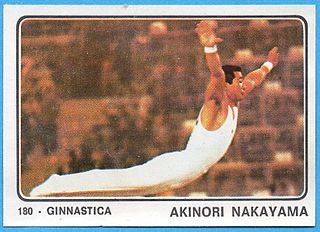
The men's rings competition was one of eight events for male competitors in artistic gymnastics at the 1972 Summer Olympics in Munich. The qualification and final rounds took place on August 27, 29 and September 1 at the Olympiahalle. There were 111 competitors from 26 nations ; nations entering the team event had 6 gymnasts while other nations could have up to 3 gymnasts. The top two places were the same as in 1968, while the next two places were taken by the same gymnasts but in the opposite order. The event was won by Akinori Nakayama of Japan, the nation's third consecutive victory in the men's rings; Nakayama was the second man to successfully defend an Olympic title in the event. Mikhail Voronin's second consecutive silver extended the Soviet Union's podium streak in the rings to six Games. Nakayama and Voronin were the fifth and sixth men to earn multiple medals in the rings. Mitsuo Tsukahara of Japan took bronze, switching places with fourth-place finisher Sawao Kato from the previous Games.
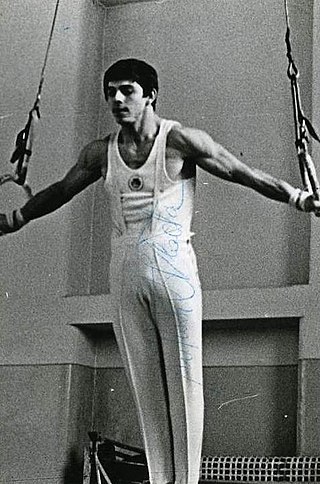
The men's rings competition was one of eight events for male competitors in artistic gymnastics at the 1976 Summer Olympics in Montreal. The qualification and final rounds took place on July 18, 20, and 23rd at the Montreal Forum. There were 90 competitors from 20 nations, with nations competing in the team event having 6 gymnasts while other nations could have up to 3 gymnasts. The event was won by Nikolai Andrianov of the Soviet Union, the nation's first victory in the rings since 1960. Another Soviet gymnast, Alexander Dityatin, took silver. The Soviet podium streak in the event reached seven Games. Dan Grecu earned Romania's first medal in the rings. Japan's three-Games gold medal streak and five-Games podium streak in the event ended as the nation's best results were fifth and sixth places.

The men's rings competition was one of eight events for male competitors in artistic gymnastics at the 1980 Summer Olympics in Moscow. The qualification and final rounds took place on July 20, 22 and 25th at the Luzhniki Palace of Sports. There were 65 competitors from 14 nations, with nations competing in the team event having 6 gymnasts while other nations could have to up to 3 gymnasts. The event was won by Alexander Dityatin of the Soviet Union, the nation's fifth victory in the rings, with fellow Soviet Aleksandr Tkachyov taking silver. It was the second consecutive Games that the Soviet Union had the top two men in the rings. Dityatin, the silver medalist in Montreal 1976, was the seventh man to win multiple medals in the rings. Jiří Tabák earned Czechoslovakia's first medal in the event since 1948.

The men's rings competition was one of eight events for male competitors in artistic gymnastics at the 1968 Summer Olympics in Mexico City. There were 117 competitors from 28 nations, with nations in the team competition having up to 6 gymnasts and other nations entering up to 3 gymnasts. The event was won by Akinori Nakayama of Japan, the nation's second consecutive victory in the rings event. Mikhail Voronin took silver to extend the Soviet Union's podium streak in the event to five Games, while Sawao Kato of Japan finished with bronze.

The men's horizontal bar competition was one of eight events for male competitors in artistic gymnastics at the 1960 Summer Olympics in Rome. It was held on 5, 7, and 10 September at the Baths of Caracalla. There were 130 competitors from 28 nations, with nations in the team competition having up to 6 gymnasts and other nations entering up to 2 gymnasts. The event was won by Takashi Ono of Japan, the nation's second consecutive victory in the men's parallel bars. Masao Takemoto gave Japan a second medal with his silver. Ono and Takemoto were the third and fourth men to win multiple medals in the parallel bars; Ono was the first to win two gold medals in the event. Boris Shakhlin of the Soviet Union took bronze.

The men's vault competition was one of eight events for male competitors in artistic gymnastics at the 1960 Summer Olympics in Rome. It was held on 5, 7, and 10 September at the Baths of Caracalla. There were 129 competitors from 28 nations, with nations in the team competition having up to 6 gymnasts and other nations entering up to 2 gymnasts. For the second straight Games, there was a tie for first place in the vault. Boris Shakhlin of the Soviet Union and Takashi Ono of Japan each received a gold medal. It was the third consecutive Games with a gold medal for the Soviets. Ono, who had taken bronze in 1952, became the second man to win multiple vault medals. Third place and the bronze medal went to Soviet Vladimir Portnoi.
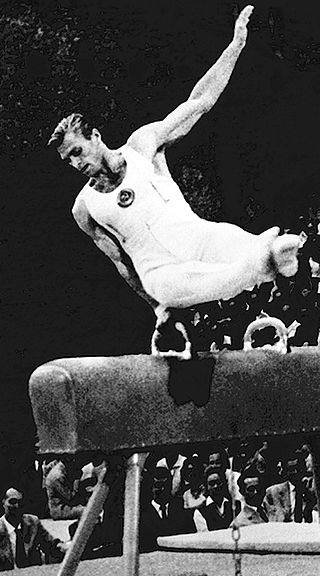
The men's pommel horse competition was one of eight events for male competitors in artistic gymnastics at the 1960 Summer Olympics in Rome. It was held on 5, 7, and 10 September at the Baths of Caracalla. There were 128 competitors from 28 nations, with nations in the team competition having up to 6 gymnasts and other nations entering up to 2 gymnasts. There was a tie for first place in the pommel horse. Boris Shakhlin of the Soviet Union and Eugen Ekman of Finland each received a gold medal. It was the third consecutive Games with a gold medal for the Soviets, as Shakhlin became the first man to successfully repeat as Olympic champion in the event. Ekman's medal was the only medal in men's artistic gymnastics in 1960 that did not go to the Soviet Union or Japan. Third place and the bronze medal went to Japan's Shuji Tsurumi.
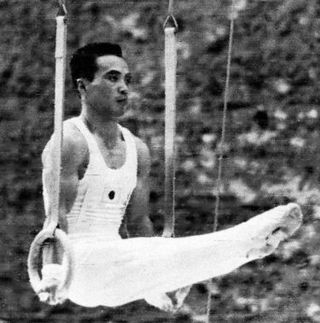
The men's rings competition was one of eight events for male competitors in artistic gymnastics at the 1960 Summer Olympics in Rome. It was held on 5, 7, and 10 September at the Baths of Caracalla. There were 129 competitors from 28 nations, with nations in the team competition having up to 6 gymnasts and other nations entering up to 2 gymnasts. The event was won by Albert Azaryan of the Soviet Union, the first man to successfully defend an Olympic title in the rings. Boris Shakhlin took silver, making it the third consecutive Games the Soviets finished in the top two. Takashi Ono tied with Velik Kapsazov for bronze, giving Japan its second consecutive Games with at least one bronze medal and Bulgaria its first medal in the rings.

The men's parallel bars competition was one of eight events for male competitors in artistic gymnastics at the 1960 Summer Olympics in Rome. It was held on 5, 7, and 10 September at the Baths of Caracalla. There were 129 competitors from 28 nations, with nations in the team competition having up to 6 gymnasts and other nations entering up to 2 gymnasts. The event was won by Boris Shakhlin of the Soviet Union, the nation's second consecutive victory in the men's parallel bars. Giovanni Carminucci earned Italy's first medal in the event since 1932 with his silver. Takashi Ono of Japan took bronze for a second consecutive Games, making him the fourth man to win multiple medals in the event.

The men's vault competition was one of eight events for male competitors in artistic gymnastics at the 1956 Summer Olympics in Melbourne. It was held from 3 to 7 December at the Melbourne Festival Hall. There were 63 competitors from 18 nations, with nations in the team competition having up to 6 gymnasts and other nations entering up to 3 gymnasts. The event was won by Helmut Bantz of the United Team of Germany and Valentin Muratov of the Soviet Union, who tied for the top place. Soviet Yuri Titov finished third to win the bronze medal.

The men's horizontal bar competition was one of eight events for male competitors in artistic gymnastics at the 1956 Summer Olympics in Melbourne. There were 63 competitors from 18 nations, with nations in the team competition having up to 6 gymnasts and other nations entering up to 3 gymnasts. The event was won by Takashi Ono of Japan, with his countryman Masao Takemoto taking bronze. Silver went to Yuri Titov of the Soviet Union. Japan and the Soviet Union each earned their first horizontal bar medals.

The men's parallel bars competition was one of eight events for male competitors in artistic gymnastics at the 1956 Summer Olympics in Melbourne. It was held from 3 to 7 December at the Melbourne Festival Hall. There were 63 competitors from 18 nations, with nations in the team competition having up to 6 gymnasts and other nations entering up to 3 gymnasts. The event was won by Viktor Chukarin of the Soviet Union, the nation's first victory in the parallel bars. Japan took three medals: a silver by Masumi Kubota and bronzes by Takashi Ono and Masao Takemoto. It was the third time a nation had won three medals in the event in the same Games: the United States had swept the medals in 1904 and Switzerland had earned a gold and two bronzes in 1948. Chukarin was the third man to win multiple medals in the parallel bars; Ono would become the fourth in 1960.

The men's pommel horse competition was one of eight events for male competitors in artistic gymnastics at the 1956 Summer Olympics in Melbourne. It was held from 3 to 7 December at the Melbourne Festival Hall. There were 63 competitors from 18 nations, with nations in the team competition having up to 6 gymnasts and other nations entering up to 3 gymnasts. The event was won by Boris Shakhlin of the Soviet Union, the nation's second consecutive victory in the pommel horse. Takashi Ono earned Japan's first medal in the event with his silver. Soviet Viktor Chukarin became the first man to win multiple medals in the pommel horse, adding a bronze to his 1952 gold.
The men's artistic individual all-around competition at the 1956 Summer Olympics was held at the West Melbourne Stadium from 3 to 7 December. It was the twelfth appearance of the event. There were 63 competitors from 18 nations, with each nation entering up to 6 gymnasts. The event was won by Viktor Chukarin of the Soviet Union, the second man to successfully defend an all-around title and fourth to earn multiple medals of any color. His countryman Yury Titov took bronze. Takashi Ono of Japan earned silver. It was the first medal in the event for Japan, beginning that nation's nearly four-decade battle with the Soviet Union for dominance. Every men's all-around medal from 1956 to 1976 was won by a gymnast from one of those two nations; from 1952 to 1988, the Soviets won six of the ten gold medals while Japan won the other four.

The men's artistic individual all-around competition at the 1960 Summer Olympics was held at the Baths of Caracalla from 5 to 7 September. It was the thirteenth appearance of the event. There were 130 competitors from 28 nations. Each nation entered a team of six gymnasts or up to two individual gymnasts. The event was won by Boris Shakhlin of the Soviet Union, the nation's third consecutive victory in the event, putting the Soviets second all-time to that point. Takashi Ono of Japan and Yuri Titov of the Soviet Union repeated as silver and bronze medalists, respectively; they were the fifth and sixth men to earn multiple medals in the event.
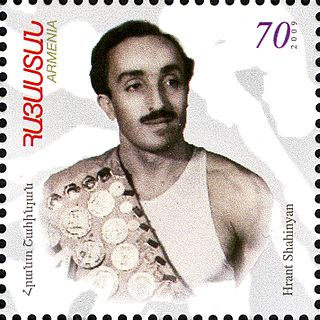
The men's rings competition at the 1952 Summer Olympics was held at Töölö Sports Hall, Exhibition Hall I from 19 to 21 July. It was the eighth appearance of the event. There were 185 competitors from 29 nations, with each nation sending up to 8 gymnasts. The Soviet Union, in its debut in the event, won a medal of every color but did not quite sweep the medals as there was a tie for third. Hrant Shahinyan was the winner, Viktor Chukarin took silver, and Dmytro Leonkin shared bronze with Hans Eugster of Switzerland.
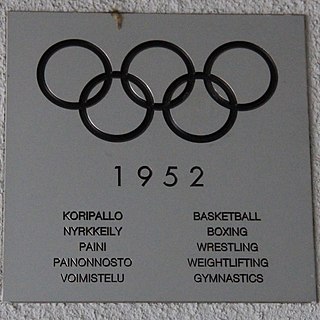
The men's vault competition at the 1952 Summer Olympics was held at Töölö Sports Hall, Exhibition Hall I from 19 to 21 July. It was the eighth appearance of the event. There were 185 competitors from 29 nations, with nations competing in the team event entering up to 8 gymnasts and other nations able to send up to 3. The event was won by Viktor Chukarin of the Soviet Union, the nation's first medal in the event in its first appearance. Japan also earned its first medal(s): a silver and two bronzes, as Masao Takemoto finished second and there was a tie for third between Takashi Ono and Tadao Uesako.
